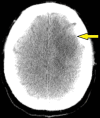Awake Craniotomy for a Frontal Astrocytoma: A Case Report
- PMID: 38836145
- PMCID: PMC11149057
- DOI: 10.7759/cureus.59667
Awake Craniotomy for a Frontal Astrocytoma: A Case Report
Abstract
Awake craniotomy is a surgical procedure that has been gaining significance over the past decades. Neuronavigation is an intraoperative technology that locates tumors and monitors the brain cortex during awake craniotomy. The presence of cerebral low-grade gliomas in the frontal lobe creates a risk of affecting vital centers of the brain cortex during surgery. We present a clinical case of a 42-year-old male patient who entered the neurosurgery clinic with a clinical manifestation of headache for two months. MRI showed evidence of the recurrence of a left frontal glioma. Differential diagnoses of frontal gliomas include metastases, abscesses, and cysts. The pathophysiologic background of the disease is the mutation of neuroglial cells, which leads to an abnormal and uncontrollable proliferation. Under sleep-awake anesthesia, operative treatment was performed through left frontal awake craniotomy under neuronavigation. As a result, a total excision was achieved. Motor functions of the right limbs and speech have been preserved. The patient was mobilized on the day after the intervention. Surgery-related complications were not observed. The patient had relief from the symptoms and was discharged on the fifth day. Awake craniotomy combined with neuronavigation was the most efficient and the least harmful method for the excision of the tumor. For low-grade gliomas localized in the frontal area of the encephalon, awake craniotomy is the only secure option for surgery.
Keywords: astrocytoma; awake craniotomy; case report; frontal tumour; low-grade gliomas; neuronavigation guidance.
Copyright © 2024, Velchev et al.
Conflict of interest statement
The authors have declared that no competing interests exist.
Figures





Similar articles
-
Multimodal protocol for awake craniotomy in language cortex tumour surgery.Acta Neurochir (Wien). 2006 Feb;148(2):127-37; discussion 137-8. doi: 10.1007/s00701-005-0706-0. Epub 2005 Dec 30. Acta Neurochir (Wien). 2006. PMID: 16374563 Clinical Trial.
-
Awake craniotomy, electrophysiologic mapping, and tumor resection with high-field intraoperative MRI.World Neurosurg. 2010 May;73(5):547-51. doi: 10.1016/j.wneu.2010.02.003. World Neurosurg. 2010. PMID: 20920940
-
Awake Craniotomy with Noninvasive Brain Mapping by 3-Tesla Functional Magnetic Resonance Imaging for Excision of Low-grade Glioma: A Case of a Young Patient from Pakistan.Asian J Neurosurg. 2018 Apr-Jun;13(2):471-474. doi: 10.4103/ajns.AJNS_144_16. Asian J Neurosurg. 2018. PMID: 29682064 Free PMC article.
-
Awake surgery with cortical-subcortical mapping in diffuse gliomas adjacent to central lobe. Report of two cases and literature review.Cir Cir. 2019;87(4):459-465. doi: 10.24875/CIRU.18000753. Cir Cir. 2019. PMID: 31264990 Review. English.
-
Post-operative morbidity ensuing surgery for insular gliomas: a systematic review and meta-analysis.Neurosurg Rev. 2020 Jun;43(3):987-997. doi: 10.1007/s10143-019-01113-4. Epub 2019 May 17. Neurosurg Rev. 2020. PMID: 31098791
References
Publication types
LinkOut - more resources
Full Text Sources
Research Materials
Miscellaneous
